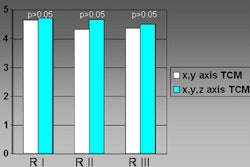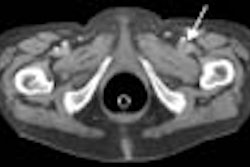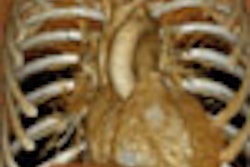How much is too much radiation exposure for a given examination? A new publication offers some specific numbers to measure against -- which may be particularly useful for facilities seeking accreditation or looking to save money on pricey x-ray tubes.
A task force organized by the American Association of Physicists in Medicine (AAPM) is endorsing levels for common exams in a new paper published online and slated for the May issue of Radiology.
Meanwhile, the American College of Radiology (ACR) is now reviewing exposure data from its popular computed tomography accreditation program, with a future goal that would require participating facilities to come under specific levels in CT exams.
The reference values (RVs) now recommended by the AAPM are based on levels achieved by 75% to 80% of U.S. facilities in a nationwide survey. The following are the levels set for various exams:
- Posteroanterior view of the chest: 0.25 mGy
- Anteroposterior view of the cervical spine: 1.25 mGy
- Anteroposterior view of the abdomen: 4.50 mGy
- Anteroposterior view of the lumbar spine: 5.0 mGy
- Head CT (measured at the center of a phantom): 60 mGy
- Body CT (measured at the periphery of a phantom, 1 cm beneath the surface): 40 mGy
- Fluoroscopy, 65 mGy per minute
The RVs are defined in terms of entrance skin exposure in air, without backscatter -- except for CT, which was defined as CT dose index including backscatter.
Facilities that practice state-of-the-art imaging may find their levels to be far lower. Still, "most facilities have no idea what the dose is they're using for an examination," said Joel Gray, Ph.D., the task force chairman and director of technology for Landauer, a manufacturer of personal dosimeters based in Glenwood, IL.
If facilities that currently exceed the 80th percentile pursued the new goals, there could be a slow but substantial reduction of radiation exposure to patients, Gray said. That's what happened with an educational feedback program in England, which prompted a 30% decrease in patient exposures from specific radiographic projections over a 10-year period.
As noted by the task force, "The direct impact of the RVs on radiology will be the need for about 20% to 25% of facilities to perform radiographic examinations to investigate the reason for their higher radiation exposure levels."
But the worst outliers in America are also the least likely to participate in programs that would improve their performance, Gray acknowledged.
"The problem you have here also is that many states don't measure the patient doses," Gray said. "They send an inspector out, and they measure half a dozen different things, but they never put something representative of a patient on the table and make a measurement of the dose."
"There are a lot of facilities out there -- the small radiology office, the general practitioner, the orthopedic surgeon -- that this is never going to have an impact on unless the states do something about it," he said.
While the AAPM report recommends against using its reference values as a regulatory tool, "I think this publication and the discussion in the United States about reference levels is going to be good for raising awareness," said medical physicist Priscilla Butler, the ACR's representative on the task force and the senior director of the college's breast imaging accreditation program.
The ACR already incorporates very similar reference levels in several of its voluntary accreditation programs, Butler said.
In some of the ACR programs, a facility can lose accreditation for failing to keep exposures below stated reference levels.
The college is also moving toward a pass/fail standard on reference levels in its popular CT accreditation program, according to Krista Bush, the college's assistant director of voluntary accreditation programs.
Facilities that don't have their exposures checked on a voluntary or regulatory basis may have another incentive for self-monitoring. The AAPM report speculates that reducing exposures could significantly increase the life of x-ray tubes that cost from $5,000 to $50,000 apiece, depending on the equipment served.
"We don't have any data to say that it's going to increase tube life," Gray said. "But it seems reasonable that if you cut the exposure, and if you're cutting the tube loading per exposure by 50%, that the tube would last longer."
By Tracie L. Thompson
AuntMinnie.com staff writer
April 14, 2005
Related Reading
Report finds vendors enable excess radiation doses in pediatric CR, DR, February 4, 2005
Gonadal shield cuts scatter radiation from MDCT, January 10, 2005
Cardiology groups issue competence standards for fluoroscopic procedures, December 10, 2004
Use of pediatric head CT growing steadily in emergency departments, May 4, 2004
Constant image-noise standard lowers CT dose in pediatric exams, April 21, 2004
Copyright © 2005 AuntMinnie.com



















